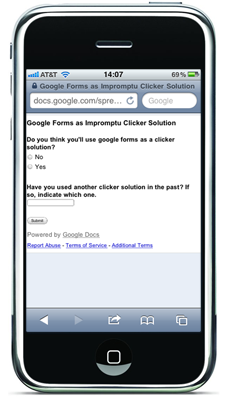Google Forms as Clicker Alternative
 We've written about Audience Response Systems (a.k.a. "Clickers") from time to time, but this novel use of Google Docs as a Clicker Alternative got us thinking about it again. Follow this example to get started with a Google-forms-based Clicker solution:
We've written about Audience Response Systems (a.k.a. "Clickers") from time to time, but this novel use of Google Docs as a Clicker Alternative got us thinking about it again. Follow this example to get started with a Google-forms-based Clicker solution:
- Log in to your Google Docs account and use the "create new" dropdown menu to make a new form. Add your questions to the form and save the results.
- Grab the form's URL and run it through a URL shortener, such as bit.ly, tinyurl.com, or goo.gl, so that your students can easily access the form on their smartphones or laptop browsers in the classroom. In this example, the form is located at http://goo.gl/tLsls. You can get the form URL by visiting the resulting spreadsheet document and clicking on "form" and then "go to live form". The URL is at the bottom of the form window.
- Ensure that the permissions are set properly on the form/spreadsheet. You can test this by visiting the shortened URL while not logged in to Google Docs. Be sure to remove any test submissions from the spreadsheet so that you don't skew the results.
When you're in the classroom, write the form address on the blackboard. Ask students to access the survey on a smartphone or computer and "vote". While they do this (or after voting is closed), visit your Google Docs account and access the "summary of responses" under the "form" menu on the associated spreadsheet file.
For maximum flexibility, you might consider setting up a form without a fixed question. In this scenario, the response options could be "yes", "no", and "other" (with a space to provide textual feedback). This would allow you to pose an impromptu question in the classroom, record the results, and then look at the feedback with your students. Simply clearing out the spreadsheet data will reset the form for re-use in subsequent class sessions.
Finally, because some students may lack a device with which to respond, consider grouping students for a think-pair-share type of exercise. This very effective teaching technique offers a break from the regular pace of the class and requires students to reason through their answers with peers prior to responding.


